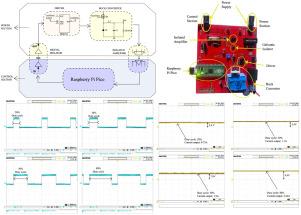Temperature control board design and validation for skipper-CCD sensors using a buck converter
IF 2.1
Q3 ENGINEERING, ELECTRICAL & ELECTRONIC
引用次数: 0
Abstract
This article describes the creation and validation of a custom temperature control board explicitly designed for Skipper-CCD sensors. The board is versatile and can be used in various experimental setups. It consists of two galvanically isolated sections: a control section equipped with a Raspberry Pi and essential instrumentation for measurement and protection, and a power section with a buck converter and additional instrumentation for enhanced protection and monitoring. The seamless integration of these sections provides robust temperature control and comprehensive safeguards against potential issues. Through careful design and extensive experimental validation, the developed board ensures precise thermal management tailored to the unique needs of Skipper-CCD sensors. Its effectiveness has been demonstrated in the OSCURA experiment and can serve as a model for potential applications in other projects.

采用降压变换器的陀螺ccd传感器温控板设计与验证
这篇文章描述了一个定制的温度控制板的创建和验证,明确地为船长- ccd传感器设计。该板是多功能的,可用于各种实验设置。它由两个电隔离部分组成:一个控制部分配备了树莓派和用于测量和保护的基本仪器,一个电源部分配备了降压转换器和用于增强保护和监测的额外仪器。这些部分的无缝集成提供了强大的温度控制和针对潜在问题的全面保障。通过精心设计和广泛的实验验证,开发的电路板确保精确的热管理,以满足Skipper-CCD传感器的独特需求。其有效性已在OSCURA实验中得到证明,并可作为其他项目潜在应用的模型。
本文章由计算机程序翻译,如有差异,请以英文原文为准。
求助全文
约1分钟内获得全文
求助全文
来源期刊

HardwareX
Engineering-Industrial and Manufacturing Engineering
CiteScore
4.10
自引率
18.20%
发文量
124
审稿时长
24 weeks
期刊介绍:
HardwareX is an open access journal established to promote free and open source designing, building and customizing of scientific infrastructure (hardware). HardwareX aims to recognize researchers for the time and effort in developing scientific infrastructure while providing end-users with sufficient information to replicate and validate the advances presented. HardwareX is open to input from all scientific, technological and medical disciplines. Scientific infrastructure will be interpreted in the broadest sense. Including hardware modifications to existing infrastructure, sensors and tools that perform measurements and other functions outside of the traditional lab setting (such as wearables, air/water quality sensors, and low cost alternatives to existing tools), and the creation of wholly new tools for either standard or novel laboratory tasks. Authors are encouraged to submit hardware developments that address all aspects of science, not only the final measurement, for example, enhancements in sample preparation and handling, user safety, and quality control. The use of distributed digital manufacturing strategies (e.g. 3-D printing) is encouraged. All designs must be submitted under an open hardware license.
 求助内容:
求助内容: 应助结果提醒方式:
应助结果提醒方式:


